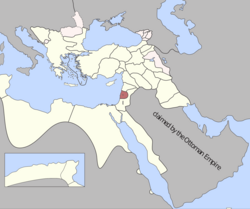Eyalet of Sidon
| Eyaleti Safed-Sayda-Beyrut | |||||
| Eyalet of the Ottoman Empire | |||||
|
|||||
| Sidon Eyalet in 1795 | |||||
| Capital |
Safed (1660) Sidon (1660–1775) Acre (1775–1841) Beirut (1841–1864) |
||||
| History | |||||
| • | Established | 1660 | |||
| • | Disestablished | 1864 | |||
| Today part of |
|
||||
The Eyalet of Sidon (Ottoman Turkish: ایالت صیدا; Eyālet-i Ṣaydā), was an eyalet (also known as a beylerbeylik) of the Ottoman Empire. In the 19th century, the eyalet extended from the border with Egypt to the Bay of Kesrouan, including parts of modern Israel, Palestine and Lebanon.
Depending on the location of its capital, it was also known as the Eyalet of Safad, Beirut or Akka (Acre).
Ottoman rulers considered creating the Province as early as 1585. The districts of Beirut-Sidon and Safed (encompassing much of the Galilee) were united under the rule of Ma'nid Emir Fakhr-al-Din ibn Maan. The Province was briefly created during Fakhr-al-Din's exile in 1614–15, and recreated in 1660. The province continued to be subordinated in some ways, both in fiscal and political matters, to the Damascus province out of which it was created.
Despite conflicts in the 1660s, the Maan family "played the leading role in the management of the internal affairs of this eyalet until the closing years of the 17th century, perhaps because it was not possible to manage the province-certainly not in the sanjak of Sidon-Beirut-without them." The Maans were succeeded by the Shihab family in ruling Sidon-Beirut from the final years of the 17th century through the 19th century. The Maans were first recognized as "emirs" in 1592 when Fakhr al-Din Maan was made (honorary) governor of the sanjak of Safad, and both the Maans and the Shihabis were recognized by the Ottomans as incumbents of an only vaguely defined, only implicitly "Druze" emirate. They never actually exercised any administrative function beyond that of multazim (tax farmer) over several mountain districts in the eyalet of Sidon (the Shuf). In 1763 the Shihabis were also invested with tax farms in the eyalet of Tripoli that had formerly been held by the Shiite Hamada family, which marks the beginning of the "emirate"'s sovereignty over the whole of Mt Lebanon.
...
Wikipedia

